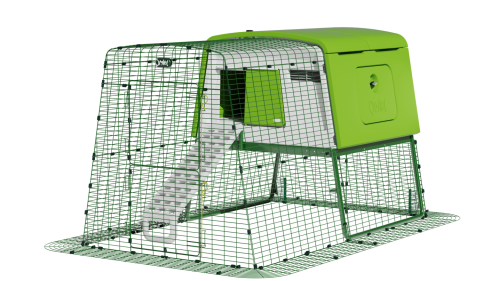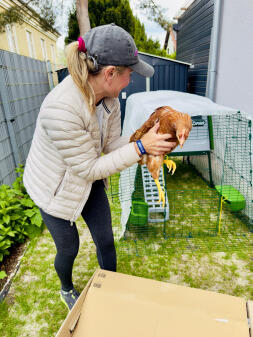Bringing chickens home is an exciting day for everyone involved. But before you bring your new hens home, you’ll need to do some prep. Whether you’re getting chicks or grown chickens, there are essentials to have on hand both for the trip home, and when introducing them to their forever home. Here is an overview of where to find the perfect chickens for your family, how to get them home, and what to do once they’ve arrived.
Getting your hens’ home ready
Before bringing chickens home, you’ll need to prepare their home. Every flock needs a chicken coop, and either a chicken run or chicken fencing for room to forage and play. Adding some chicken toys and accessories to their run will also help your hens feel right at home.
Have their feed and scratch grains ready in air-tight containers, along with any chicken supplements you plan to offer to your flock. Nesting areas should have pine shavings, straw, or aspen fiber for bedding, and the droppings tray of the chicken coop should be lined with newspaper, shavings, pine pellets, or other absorbable material.

The Eglu Cube chicken coop is the perfect home for your hens!
Special considerations for chicks
In addition to their forever home, chicks need a special temporary setup called a brooder. Brooders are part of basic care for newly hatched chicks, and your chicks will call it home for their first 12 weeks of life. For your brooder you’ll need:
- A plastic tote or other large container with tall sides
- Pine shavings
- Heat lamp or brooder plate
- Chick-sized feeders and waterers
- Digital thermometer with an easy-to-read display
- Chick starter food
While your chicks are growing in their brooder, you can prepare their forever home. Most breeds of chickens are fully-feathered around 6 weeks old and can begin making outdoor excursions to get acquainted with their coop.
Where to get chicks and chickens
Chickens and even chicks can be found year-round if you know where to look. If you’re searching for adult hens of a certain breed, Facebook groups, websites, or other online resources can put you in contact with breeders of the specific chickens you’re looking for. If you aren’t set on purebred hens, or don’t have a breed preference, you can reach out to individuals, rescue groups, or even your local animal shelter for hens to adopt.
Chicks can be purchased in the spring and summer at local feed stores, or online year-round through chicken hatcheries. If you’re purchasing chicks through a hatchery, they will be very young — between 24 and 72 hours old, and will arrive via the US postal service at your local post office. Some hatcheries may offer local pickup, but many do not allow visitors due to contamination concerns.
Picking out your chickens
If you go in person to select your chickens, there are a few things to keep in mind. A healthy hen will have a bright and alert appearance, vibrant plumage, and an overall healthy look to them. The exception to this is if hens are molting, which primarily occurs in late summer to early fall, but can also occur in the spring.
Like adult hens, chicks should also have a healthy appearance, but keep in mind that growing chicks molt frequently in order to grow adult feathers. Chicks over 4 or 5 days old may start to appear patchy or mottled with longer feathers sticking through their downy fluff. Molting chicks should still appear healthy and energetic.
Transporting your chickens home
Aside from mail order chicks, you’ll need a way to get your chickens home, unless you’ve arranged delivery with their breeder. Chicks are often provided a cardboard carrier lined with shavings for their journey home, but adult hens are a little trickier to transport.
Dog kennels can make good transportation apparatuses for chickens, but take care that the wire is not large enough for their legs and feet to get caught. Kennels with solid sides make the best carriers for chickens. Other options for transporting adult hens include:
- Appropriately sized individual cardboard boxes with several openings cut for ventilation
- Storage totes with several holes cut into the lid
- Wire cages meant for rabbits or other small animals, with squares less than ½ inch openings
Solid containers should have a layer of pine shavings or newspaper to absorb droppings and to provide footing. Try to transport your chickens in a climate controlled environment, such as the interior of your vehicle. Keep your radio turned down to a comfortable level to avoid additional stress to your chickens.
Quarantining new flock members
When you’re bringing new chickens home to your existing flock, you’ll need to delay introductions. Quarantining new chickens for at least 2 weeks (but ideally up to 4 weeks) will ensure that you aren’t introducing illness to your existing hens along with their new flock mates. After the concern for illness has passed, you can begin introducing your flock slowly to their new friends.
Omlet and your new chickens
Whether you’re preparing a home for your brand new flock, or adding chickens to your existing flock, we have the products to make your hens’ homecoming a success. From large chicken coops to transitional or quarantine small chicken coops and chicken runs with partitions, you can introduce new flock members to their homes and fellow feathered friends with ease. Our designs make caring for chickens easy and enjoyable - so you can spend more time building a bond with your flock.









Comments
Jen, 6 April 2022
Are hybrid hens better for beginners and how can you tell what breed they are from. Would this be by the different colours?
Sally, 29 April 2020
I have just put the new chickens into the coop but they don't want to come out. Unsurprising as it's raining. Should I put some food in the coop, or will that just encourage them to stay here and never venture out? I don't want them to be in lockdown too!
Tia, 10 April 2019
I’m getting chickens tomorrow so please reply ASAP , I beg . After the first day and night having them locked in the coop getting used to the house with an attached coop, I have a bigger coop (fenced) and a big garden , can I let them run free in the garden in the morning after or do I have to get them used to the bigger coop for a whole day or can I just let them out the morning after the first day Thanks xx